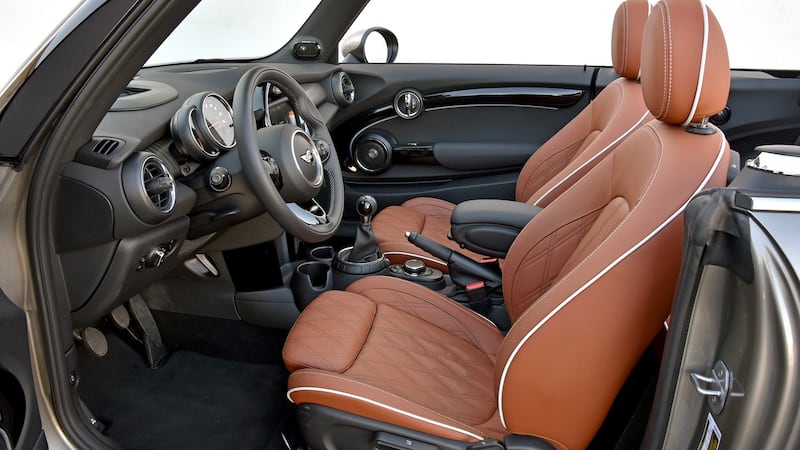The essential problem is that Ireland isn't California. We don't have drive-through doughnut shops, our police officers don't drive XXL Ford Crown Victorias and the sun does not shine down from a cloudless, azure sky every day.
If it did perhaps we too would buy lots and lots of convertibles and perhaps then, the new Mini Convertible might make a trifle more sense to us than it currently does.
Just as with the hatchback Mini, behind rather familiar looks there lies a great deal of newness. Compared with the old Mini Convertible, this new one is longer and wider, has a longer wheelbase and does away with the awkward-looking fixed rollover hoops of the old one. The roof still sits, slightly pram-like, on top of the rear deck, but it’s a faster and sleeker arrangement than before – it can be raised or lowered in a claimed 18 seconds and that is while the car is moving at speeds of up to 30km/h.

Practical
The boot is a little bigger and more practical than before too; 215 litres with the roof up, or 160 litres with the roof down. Not a lot perhaps, but it makes the Mini Convertible just about practical enough for a lightly-packed weekend away – if you don’t mind getting more than one day out of a shirt.
Right, that’s the practical stuff out of the way with, on with the fun. Because, make no mistake, the Mini remains a hugely fun car to drive and still has one of the very best and most accomplished front-wheel drive chassis around. The Latigo Canyon road runs from just off the main Malibu Coast road in the low-lying mountains that fringe southern California.
It's a relatively quiet road, one with really only the occasional cyclist or slow-moving local to interrupt your progress, and it does a pretty good impression of one of the roads that winds from Nice or Monaco, up the Alpes-Maritimes and on to the massif behind.
It’s spectacularly tight and twisty, with far too many distractingly beautiful vistas lurking just the other side of the Armco, and it could have been made and laid for the Mini.
We were in a Cooper S, so the front end had to cope with 192hp from the 2.0-litre, four-cylinder engine (not to mention the extra weight of a six-speed automatic gearbox) but even so, the Mini flung itself through Latigo Canyon’s twists and turns with proper vim, the front end biting hard into corners, the rear wiggling about a little to help you balance the car in the turn, and only the occasional bit of camber-following or a blip of ABS pulse to let you know you’re trying just a bit too hard. Great steering – heavy and meaty, but still quick across its locks and with a modicum of feel and feedback, and a well-tied down chassis that, for the most part, resists the temptation to bounce or jitter about the place. In that respect it’s a far better performer than the old Mini, which gave in too easily to harshness in the suspension.
Utterly steady
Most impressively, here’s a convertible that has had its roof removed with no apparent penalty in body stiffness. Many a car-maker has made many claims about being able to chop the roof off without giving up any rigidity, but slack steering and a wobbling rear-view mirror almost always gave the game away.
Not so for the Mini Convertible – it has bracing struts under the body work, and a stiffened-up engine pan to help keep the body in a more solid state and the result is uncorrupted steering and a mirror that, even with the Sport setting and the firmer electronic dampers engaged, remained utterly steady. It's impressive enough to allow the Mini to compete with purpose-built convertibles such as the Mazda MX-5 or Porsche Boxster in the stiffness stakes, yet the Mini has an extra pair of at least partially usable seats behind.
There’s a broad engine range, but it’s tempting to say it’s best to avoid the undoubted charms of this sporty Cooper S version and actually go for the most basic 102hp Mini One. You won’t get the oomph, but then who needs that much oomph in a convertible? Convertibles are for cruising, so a lack of power shouldn’t stymie your style, and you get the same fully-open effect when the roof is down (unlike key rivals such as the Fiat 500C and DS 3 Cabrio).
Problems? Well, the back seats are pretty tight (always a Mini bugbear, Clubman and Countryman excepted), the visibility out the back is rubbish (albeit augmented with a standard-fit reversing camera) and the interior is just a touch gaudy.
Still, the most basic One Convertible costs €27,270 and can be taxed for €200 a year, which doesn’t seem excessive for a car that’s this much fun, and Minis (and Mini Convertibles especially) tend to cling tightly on to their value as they slip down the second-hand ladder.
The only problem really is that we live in Ireland, not California. Ah well, we can dream.










